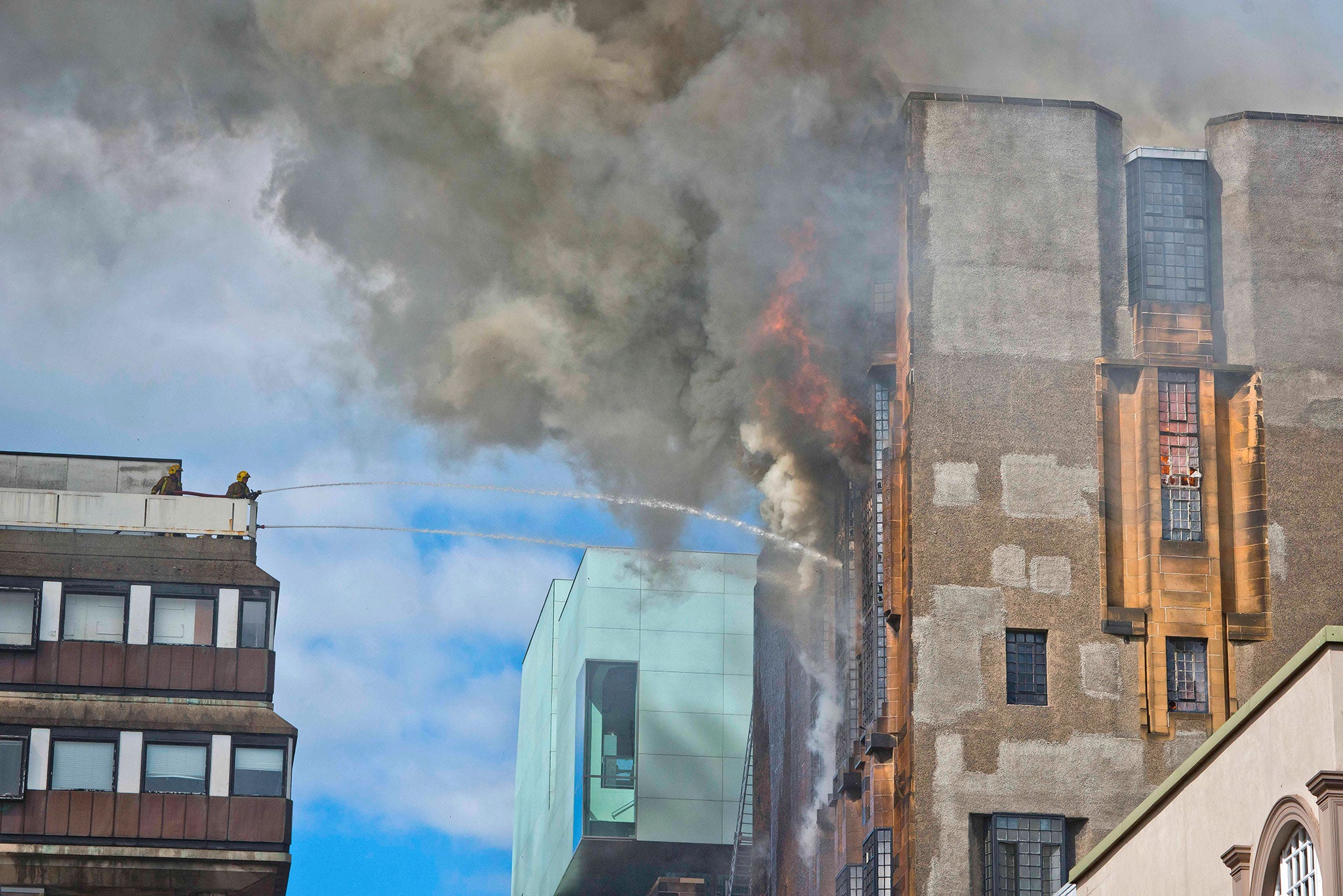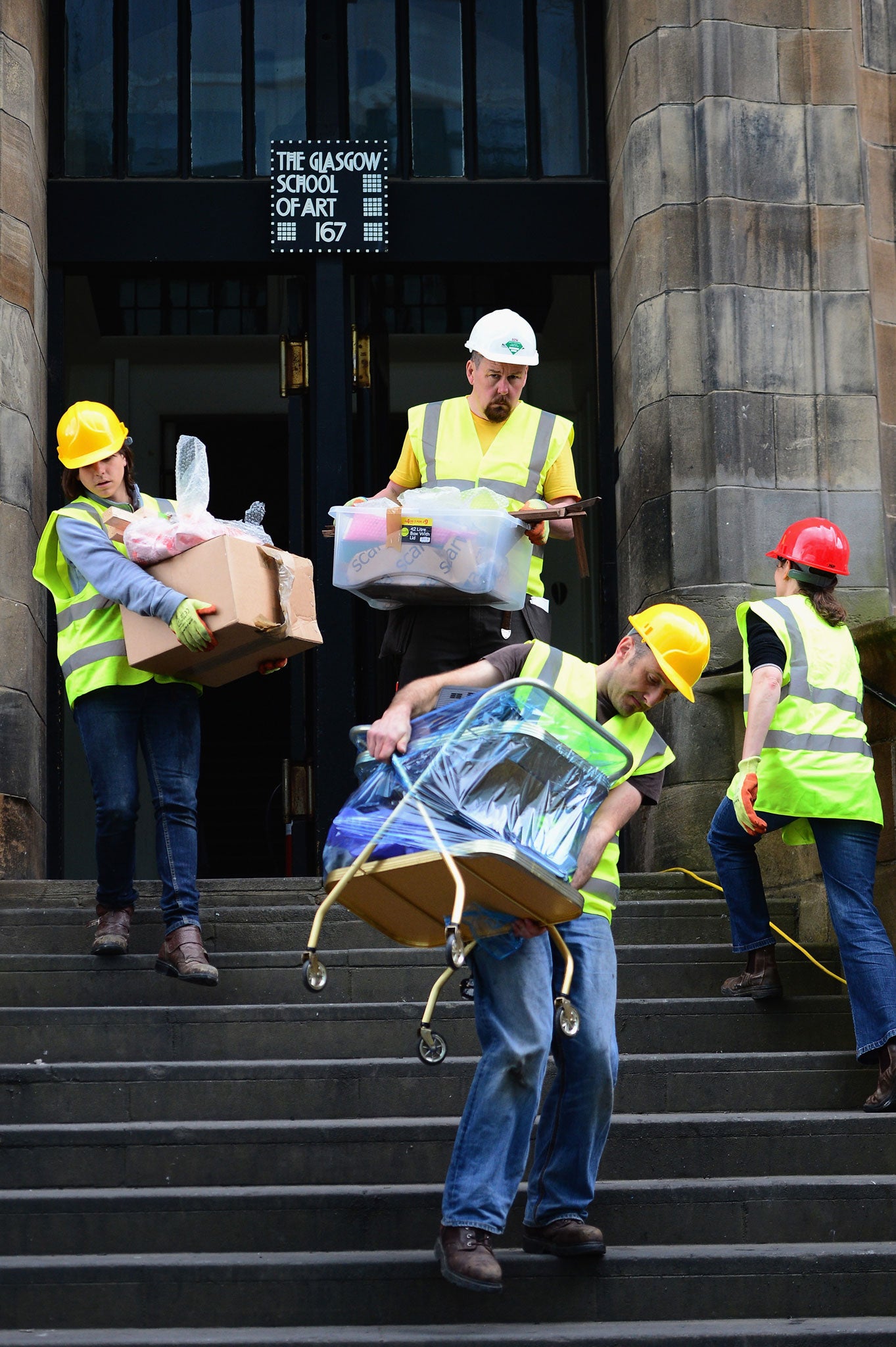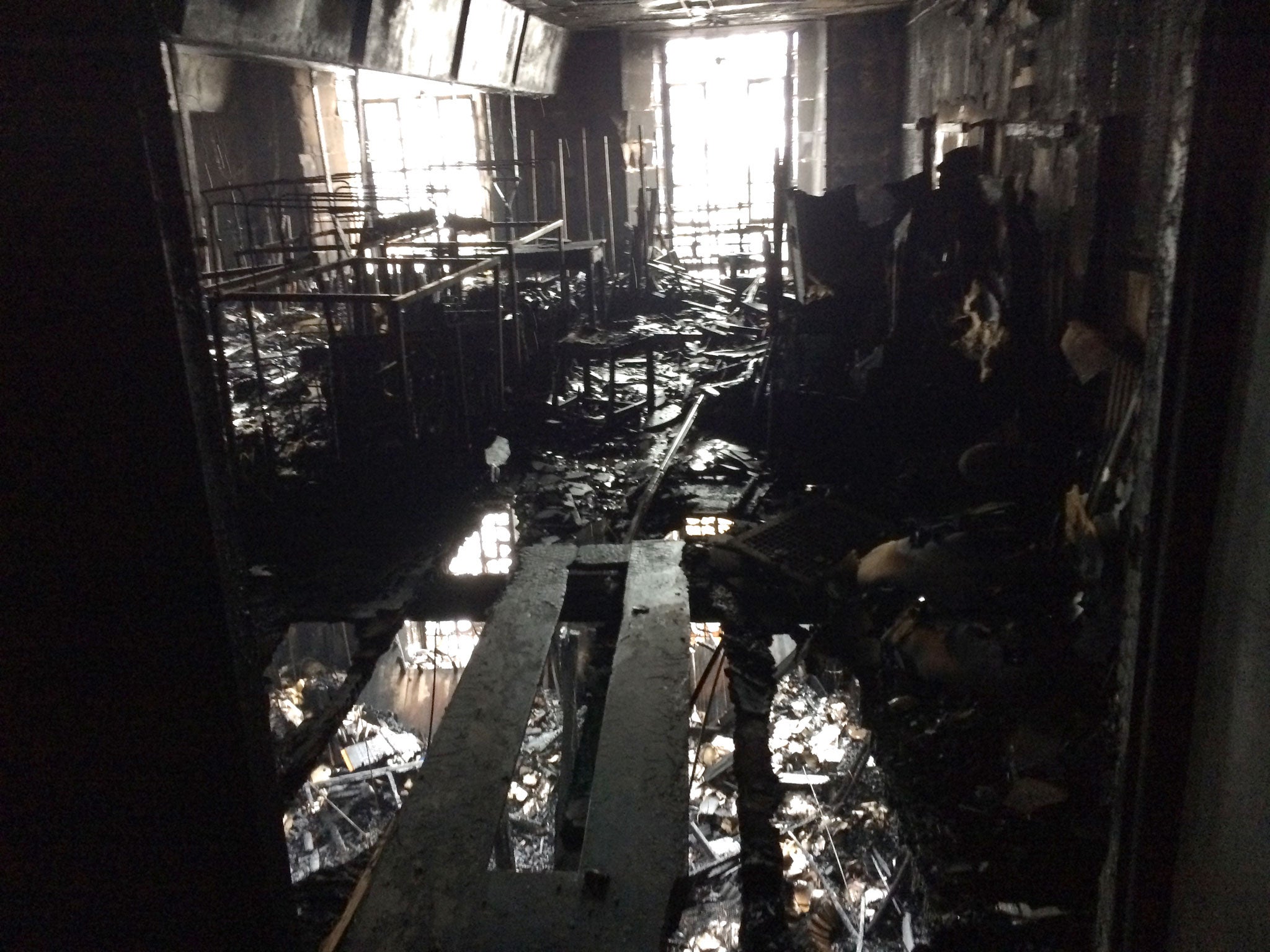What happened when Glasgow School of Art went up in smoke?
When the glorious Mackintosh Building was ravaged by fire in May, it wasn't just the city's favourite son's work which was destroyed

Your support helps us to tell the story
From reproductive rights to climate change to Big Tech, The Independent is on the ground when the story is developing. Whether it's investigating the financials of Elon Musk's pro-Trump PAC or producing our latest documentary, 'The A Word', which shines a light on the American women fighting for reproductive rights, we know how important it is to parse out the facts from the messaging.
At such a critical moment in US history, we need reporters on the ground. Your donation allows us to keep sending journalists to speak to both sides of the story.
The Independent is trusted by Americans across the entire political spectrum. And unlike many other quality news outlets, we choose not to lock Americans out of our reporting and analysis with paywalls. We believe quality journalism should be available to everyone, paid for by those who can afford it.
Your support makes all the difference.The call wasn't met with much concern. Over the years, at the Scottish Fire and Rescue Service's Johnstone command centre, there had been many call-outs to the famous Glasgow School of Art (GSA), always to a drill or false alarm. Nevertheless, dispatchers immediately radioed through to the three closest fire engines.
Arriving at the building – which sits proudly on Renfrew Street – four minutes later, the fire crews were struck by the speed of the evacuation as students streamed through the double doors and down the cascading front staircase.
That morning, the building had hummed as 102 final-year fine art students and their undergraduate helpers put the finishing touches to their pieces for the degree show. The product of four years of work, the alarm sounded four hours before the final deadline. It was to be the only time in that all the work was together in one place.
"That whole week was hectic," says painting and printmaking student Adam Quinn. "I was coming in at 8am and leaving at 11 at night. Sanding the walls down, painting them, cleaning everything up and installing my work. It was just the last wee bits when the alarm rang, I just needed to finish setting up."
It was not long before the firefighters shifted their approach. "We saw a wisp of smoke. It was of a not-nice colour; almost brownish," says David Goodhew, the officer in charge on the day. "That told us not just that something was on fire, but that it was a serious fire."
While black smoke points to a fire fuelled by plastic, brown indicates "a deep-seated working fire". It is the colour of smoke you get from a fire that is burning building materials – that has got into the structure of a building. As more crews arrived, events quickly took another twist, when someone pointed to smoke coming from the roof of the building. "And that didn't make sense," says Goodhew. "We'd been called to a fire in the basement."
"It's hard to overstate the importance of the building for Glasgow," says Pamela Robertson, professor of Mackintosh Studies at the Hunterian University . "In many ways, it is Glasgow's Acropolis: our building on the hill that adds lustre to the city."
Charles Rennie Mackintosh had been a 28-year-old junior draughtsman at the Glasgow architectural firm of Honeyman and Keppie when he submitted plans to a competition committee for a new building for the city's expanding art school. To be built to a budget of £14,000, the brief was made tricky by the unforgiving site: a tight plot on a steep slope, constrained by the requirement to have large, north-facing studios.
Out on its west wing, but conceptually at the building's heart, was the library. Shadowy and cloistered with dark pine and oak panelling and jutting verticals, it was breathtaking; the jewel in the crown. "One has to see the library as an integral part of the building," says Robertson. "There is the journey from the street, up the stairs, through the foyer, up into the museum space and along the corridors. There is this grand approach through the building before you arrive at the library itself. It sensitises you."
The fire that engulfed the building over the course of the day was contained within the west wing and – despite the dramatic images seen from the streets below and on television sets far and wide – only 10 per cent of the structure was lost. But the library was gone. Thanks to the quick actions of the firefighters, who effectively formed a human chain to remove the building's contents from harm's way, a number of students' work survived.
But for many who had been assigned studio space in the west wing, all or part of their portfolios were lost. The stress of a deadline is a universal experience – and it is hard to imagine a more unnerving hand-in day than the one had by the Glasgow School of Art's class of 2014.
How the fire started is unclear. Just before 1.30pm, third-year sculpture student Felix Welch was hurrying along one of the four main corridors in the basement with two tutors and a fellow student. Ahead of him, he heard a pop. "It sounded like someone slamming a door," he says. Welch took a couple more steps and saw that in one of the temporary studio spaces,a large panel of expanding foam had caught alight. One of the tutors grabbed a fire extinguisher from a bracket on the wall and tried to tackle it. But within a matter of seconds, the flames had leapt to a wooden partition wall and were spreading quickly. One of the tutors hit the alarm and they headed for the stairs.

In the days that followed different accounts of how the fire started circulated –including the suggestion that it may have begun with a rushed attempt to dry expanding foam with a hairdryer. But the prevailing version of events is that the fire was sparked by a faulty projector.
Coming out of the Bourdon Building on the other side of Scott Street, Quinn's mind was on whether he would now be able to get everything > ready in time. "My initial reaction was 'the deadline might not be five o'clock now: it'll be eight, nine, or maybe even Monday'," he says. "It didn't really seem that serious."
Milling outside, people soon began to spot the smoke coming from the roof. At first a barely-visible curl, then a streak and soon a thick yellow-charcoal plume smeared across the bright spring sky. At around 1pm, the intensity of the heat inside the building shattered one of the large north-facing windows and shards of glass fell on to the street below. The police acted quickly to seal off Renfrew Street, forcing back the last few remaining people.
The building had quickly become a victim of both its form and function; built, in large part, in timber which had spent a century soaking up turpentine. The library, of course, was packed with hundreds of thousands of pages of books. To make matters worse, the ventilation system was constructed from wood. While modern building regulations require at least an hour burning-time between floors, this system of flammable chimneys saw the fire rip through six storeys – from the basement to the roof – in just four minutes.
The students gathered at the muster point at nearby Garnethill Park. Over them, the plume grew thicker, drifting south and west across the city. Residents on the other side of the River Clyde, three-quarters of a mile to the south, smelt burning wood, while traffic slowed on the city-centre stretch of the M8 as the smoke column drifted over. In the park, rumours began to spread. A combination of titbits from people joining the throng and updates from BBC and Twitter, some said the roof was on fire, others that the blaze had spread to studio 40, to 44, 45.
Melissa Maloco's studio was directly below the Mackintosh library, while Freya Stockford's was directly above. "I knew that the damage to my work would be very severe because of where the smoke was coming from," says Maloco. "Then the BBC put up a picture they had been sent on their website. It was of firefighters pouring water in from their cranes and you could see flames coming out of one of the windows. It was on the first floor. I began to count how many along. I realised it was studio 43, my studio, and I knew I'd lost everything."

For Stockford, it was a different story. "I was totally unaware that any of my work had gone. It wasn't until the next day when I received an email sent out to staff and students which included a press release. It outlined the extent of the damage and said the area above the library had been destroyed. I'd been moved away before the fire spread and the last I'd seen was smoke coming from the roof, but not from the west end of the building."
After the initial shock, she says her emotional state "went from bad to worse": "It felt like losing an old friend".
At around 5.30pm, firefighters coming out of the building told Goodhew that the west-facing gable wall looked as if it might collapse. On the advice of a council structural engineer who had rushed to the site, Goodhew called his crews back from their position on Scott Street, from where they had been hosing water directly into the Mackintosh library.
As the evening drew in, students began to head to The State Bar off nearby Sauchiehall Street. Five hours after the fire had started, ash still rained down through dusk air thick with the smell of a pyre. The mood was sombre. "I've never been in one place with so many people crying that hasn't been a funeral," says Rob Hodge.
"It was quite grim, standing there with a pint, watching our degree show go up in flames," says Quinn. "It should have been the pint that said 'Right, that's us. We just enjoy it from here'. But instead, everyone was in tears."
The sense of grief transcended the loss of the students' personal portfolios, yet that feeling has continued to permeate within their approach to their work. "It was like mourning a death, which I know might sound over-exaggerated," says Maloco. "But I think everyone felt like that. For a period afterwards, the thought of making new work seemed very alien and I just couldn't really fathom recreating things and getting back into that process."

It was apparent on the day that much of the work in the west wing had been destroyed, while the east wing remained largely undamaged. But, says Ella Porter, "no matter which side of the building you were on, everybody felt more or less the same devastation. Everyone saw it as their building".
Up on the hill, as darkness fell, the firefighters judged the fire to be under control. Floodlights were brought in so that teams could work through the night on an "inspect and extinguish" mission to ensure that no smouldering debris remained. But, long before the lights were switched on, it was clear that nothing of the library had survived.
"I keep using the present tense," says Pamela Robertson, speaking four and a half months after the fire. "And I'm going to carry on doing that." On the day, she says she felt compelled to leave her desk and head to the GSA "to say goodbye". But now, she is optimistic.
A campaign set up in the wake of the disaster has raised between £6m and £7m to restore the building. The majority of this, £5m, has come from the UK Government while the Scottish Government has pledged to fund-match any other donations (up to £5m), accounting for the rest of the total.
Despite the iconic status of the library in the city, a debate is now under way as to whether the library should be reinstated to Mackintosh's original plans, or replaced with a new design. Local fashion entrepreneur David Mullane, chair of the Friends of the GSA organisation, came out last month declaring it would be an "embarrassment" to rebuild to Mackintosh's original plans and would amount to a flagrant display of "Mockintosh".
In the library's place, he has called for a "high functioning space, somewhat like a common room". However, the restorationists argue that the necessary materials and crafts are readily available for a faithful rebuild of the original.
All of the year's students graduated in June, assessed using extenuating circumstances protocols. Other than two who chose to return home to China, they will receive a bursary, totalling £750,000, funded by the Scottish Government. Named the Phoenix Bursary, it will allow them to study at one of several institutions around the world. The destinations are set to be announced this week, with all students planning to create original work, rather than revisiting their degree show.
Melissa Maloco has already created a handful of new pieces. A month after the fire, she returned to "The Mack". Taking ashes from the fire, she daubed them across a series of canvasses. "Carbon is the source of all new life," she explains. "Which, to me, seemed quite fitting."
Join our commenting forum
Join thought-provoking conversations, follow other Independent readers and see their replies
Comments